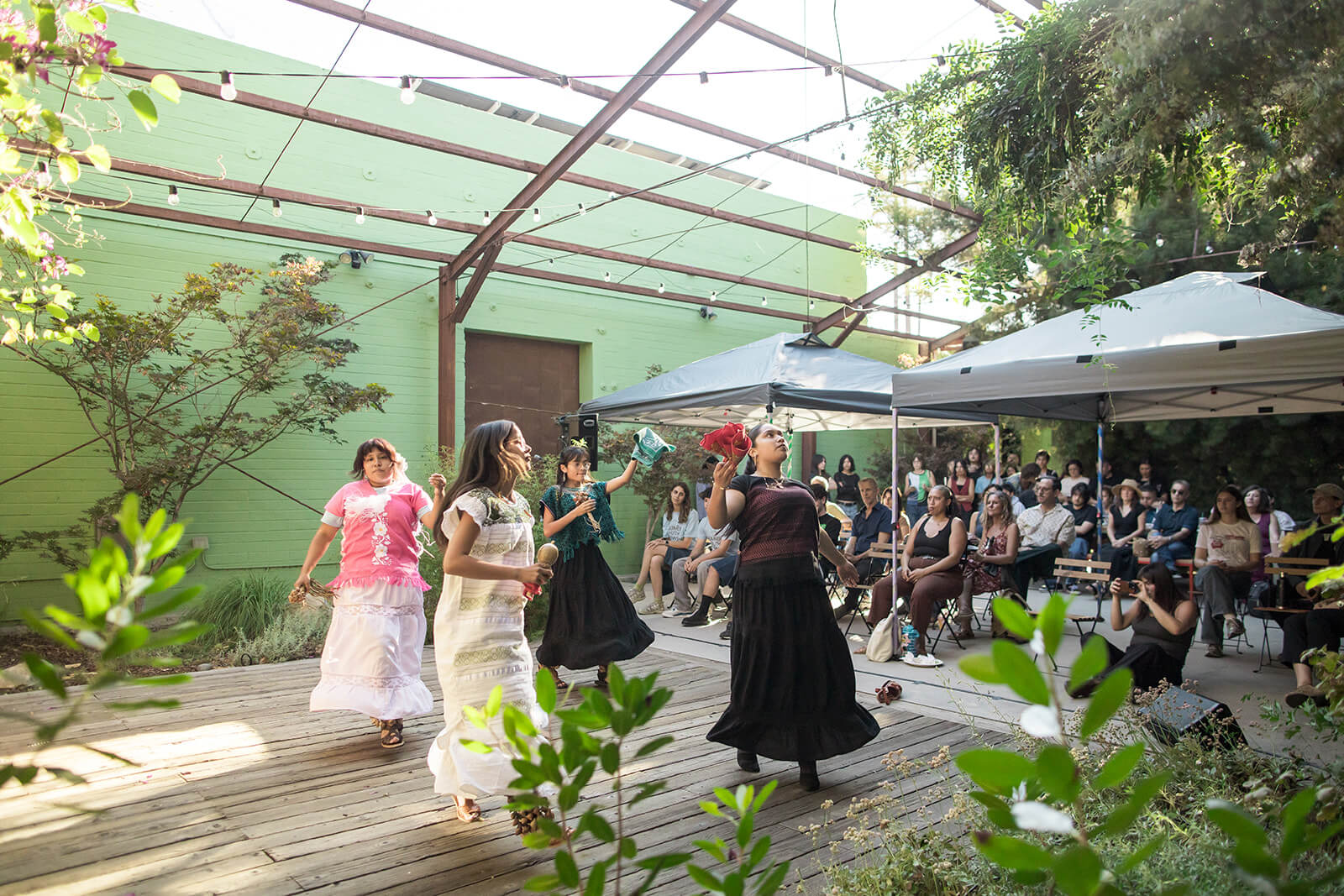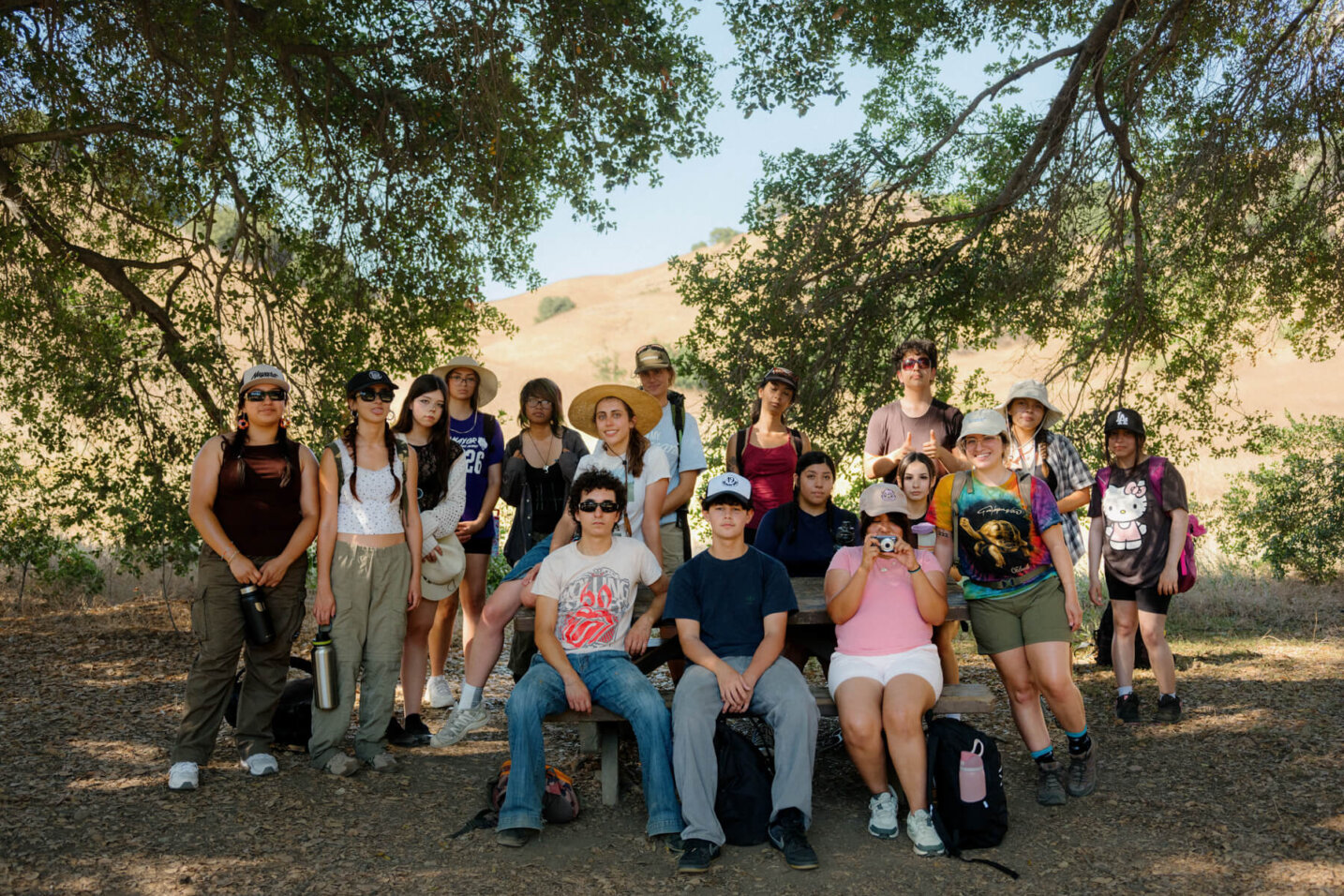Unit 1: Ecology, Community, and Place
During the first days of the Clockshop’s 2025 Summer Youth Fellowship, the fellows got to know the Los Angeles River and each other. Artist Mercedes Dorame situated the group in the long history of the Los Angeles Basin, contextualizing the landscape by sharing about her Tongva ancestry and presenting works from her multi-disciplinary artistic practice. Team-building challenges, reflective journaling, and an intention-setting collage workshop with Mercedes laid the groundwork for a meaningful six weeks to come.
Next, the fellows deepened their engagement with place by considering the complexities of map-making. They analyzed the ways historical maps of Los Angeles—from early maps drawn by Spanish settlers to later maps of oil wells and proposed freeways—have been used to extract value and exert control over land and people, then explored an alternative approach to map-making—countermapping—in which the practice of map-making becomes a form of resistance and expression. Annette Kim of USC’s Spatial Analysis Lab shared about the work she and her students are doing to map LA’s cultural richness, and fellows embarked on a summer-long project through which they reclaimed their spatial experience of Los Angeles by creating countermaps that took the form of paintings, videos, and photo-essays.
Fellows also immersed themselves in Northeast Los Angeles’s ecology through a river walk with kat superfisky, a kayak trip through the Glendale Narrows, and a native plant restoration workshop with Test Plot. They visited two of Los Angeles’s river state parks, Rio de Los Angeles and Los Angeles State Historic Park, learning about the histories and ecologies of both places and meeting with artists and activists, including Debra Scacco and Tany Ling, who have deep ties to these hard-won public spaces.
During the program’s second week, the fellows embarked on a three day camping trip to Malibu Creek State Park. There, the fellows hiked, swam, and explored the many different ecosystems that comprise the park. On hikes and at the campsite, they got to know many of Southern California’s plants and animals, from mugwort to valley oak to nesting ravens to a baby rattlesnake! The long trip allowed fellows to slow down and take time to absorb lessons from the non-human teachers around them through quiet solo exploration time, a docent-led night hike, and lots of play, journaling, and discussion. Campers also cooked for and cleaned up after each other; learned basic wilderness skills, such as Plant ID and tent construction; and participated in an epic talent show.
Unit 2: Stories, Art, and Place
In Unit 2, art-making and storytelling emerged as the focal modes of engagement for the fellows, who challenged themselves to expand their understanding of what art and storytelling look like, and can make possible.
During this unit, the cohort made several visits to Arvia Projects in Cypress Park, an important site of recent community organizing, and the canvas of resident and local mosaic artist Andrés Cortes, who has tiled hundreds of square feet on and around the property. The compound of buildings—home to many local families—was recently the site of an historic housing victory: in the face of real-estate speculation by outside developers, tenants entered into a partnership with local community organization LA Más, who purchased the site in order to keep residents in place and ensure long-term affordable housing in the neighborhood. This win was the backdrop for a collaborative mosaic mural that the fellows made on a wall at the property, celebrating local resiliency and the other, non-human members of the Northeast LA community. Fellows each represented an element of the native ecosystem—herons and crows, poppies and sage, river and mountain—using tile and glass.
In the afternoons, Clockshop’s community programs manager, Darío Herrera, invited the group to explore Clockshop’s cultural atlas project in a multi-part oral history workshop. Fellows discussed the value—and challenges—of collecting oral histories, and learned best practices. The fellows interviewed each other about their relationships to home, and then transformed their interviews into written stories, some of which were shared on Clockshop’s Substack, yOUR River.
Rosten Woo joined the fellows on the final day of Unit 2 for an all-day workshop. After Rosten shared an artist talk and answered questions about his research-based practice, the fellows broke up into groups, each assigned a contested and community-championed green space in Los Angeles: Los Angeles State Historic Park, Elephant Hills in El Sereno, Río de Los Angeles State Park, and the Verdugo Mountains site of #nocanyonhills. Fellows researched the histories of advocacy around their assigned spaces, and were tasked with designing a sign that would theoretically be placed in the site they’d researched. The day ended with a rich hourlong critique, during which Rosten and the group shared feedback on each design.
Unit 3: Making Change in Our Community
During Unit 3, fellows returned to a busy schedule of workshops and field trips, guided by the question: How do people work toward political, social, and ecological change in Northeast LA? Fellows met urban planners, community organizers, researchers, local government officials, and others to build out their own many-pronged answer to this question.
The cohort learned about mutual aid efforts in Cypress Park, participated in an interactive panel discussion with community organizers and State Parks officials about the history of Northeast LA’s urban green spaces, participated in a zine-making workshop with Theresa Hwang about community healing and transformative justice, and took part in a role-playing game led by urban planner Leslie Dinkin which invited them to think about the complex process of designing large landscape infrastructure. They also met CD1 Councilmember Eunisses Hernandez, who shared insight on her experiences before and since being elected, and advice for young people hoping to get engaged in city politics.
Unit 4: Our Unique Position
In the program’s final unit, the students were given a budget, a wide-open schedule, and a final question to answer: How can we make change in our community given our knowledge, experience, and identities? The cohort was tasked with finding a way to demonstrate and actualize their insights and learnings from the summer, as a team. Fellows identified issues that mattered to them, as well as skills, strategies, and tactics that they’d learned about over the course of the summer. They decided to focus on gentrification and its attendant issues: displacement and the risk of cultural erasure. The cohort decided to create a space of cultural resilience, storytelling, and resource-building in the form of a joyful community event called Northeast LA (NELA) United.
Over the program’s final two weeks, the fellows worked as a team, making decisions collectively and dividing tasks among committees. The stage committee developed a run of show and a vision for an open mic storytelling event in which oral histories of the neighborhood would be shared. They also coordinated performances by a stellar local teen jazz band, a danza azteca group made up of fellows and their friends, and a show-stopping song performed by another of the fellows. Other groups managed the budget, collected resources on tenant protections and immigration rights to share at the event’s resource table, got in touch with local street vendors to share tacos and raspados with attendees, and collaborated on the dozens of other tasks necessary to get such an event off the ground.
On the night of NELA United, a multi-lingual, multi-generational crowd of over 125 friends, family, and community members filled the space, sharing stories, making art, and celebrating the history and resilience of Northeast Los Angeles together.
The sense of accomplishment and community was invigorating, and in the final days of the program, as they reflected on the success of the event they’d made happen, the fellows independently decided to continue to meet and organize as a group, past the limits of the summer. Throughout the coming school year, they’ll meet twice a month—hosted at Clockshop’s space in Elysian Valley—to carry onward the work they started.


















